Home / 5 Key Basicity Trends of Amines
Amines
5 Key Basicity Trends of Amines
Last updated: January 16th, 2025 |
5 Key Amine Basicity Trends
What are the most important factors that affect the basicity of amines? Here are 5 key trends.
- Basicity increases with increasing negative charge on nitrogen. (e.g. NH2– > NH3 ).
- Conjugated amines are less basic than comparable non-conjugated amines, since the lone pair is delocalized into the pi-bond.
- Inductive effects (nearby electron-withdrawing groups) reduce the basicity of amines.
- The basicity of NH2 will be decreased if it is next to a ‘pi-acceptor‘ such as C=O to which it can donate a pair of electrons. Amides are less basic than amines.
- The basicity of nitrogen is highest for sp3-hybridized nitrogen (e.g. CH3NH2) and is lowest for sp-hybridized nitrogen (e.,g. CH3CN).
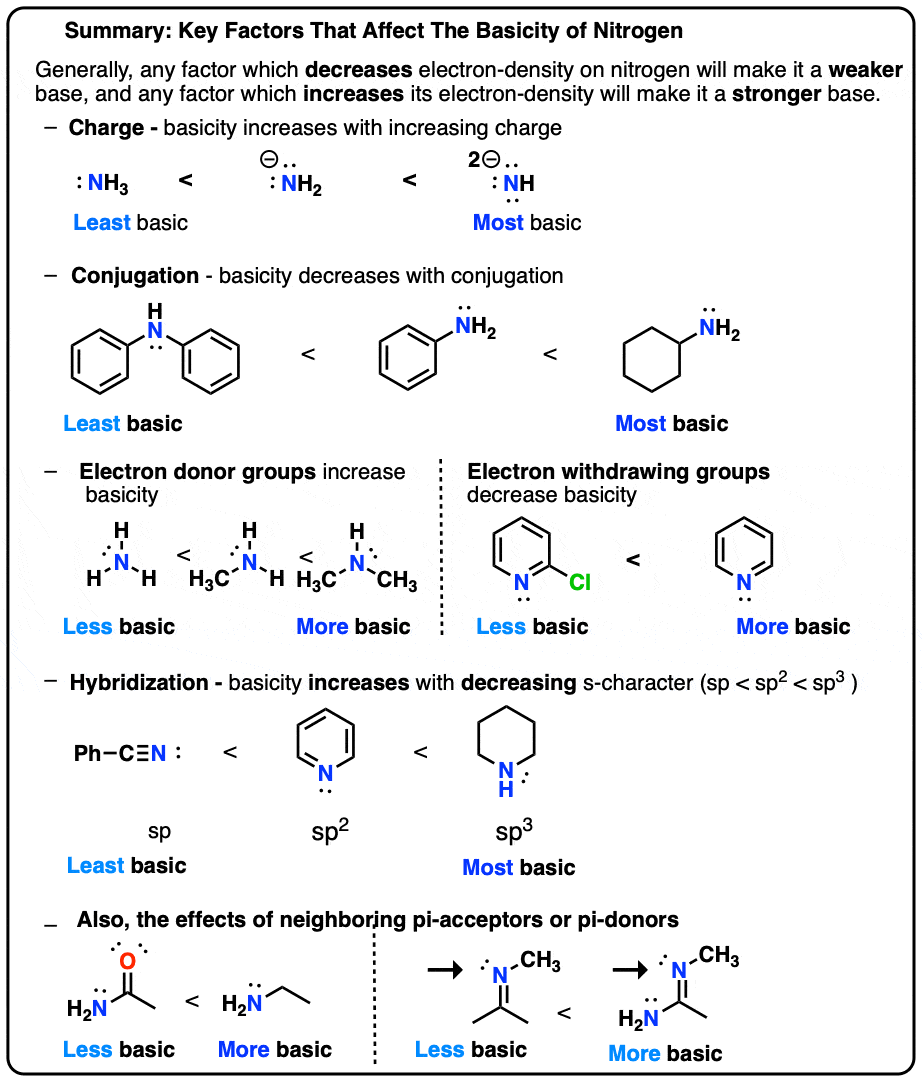
Table Of Contents
- Basicity Is A Reflection of Electron-Pair Instability
- Basicity Trend #1: Basicity Increases With Increasing Negative Charge On Nitrogen
- Basicity Trend #2: “Resonance”, or, Conjugated versus Non-Conjugated Amines
- Basicity Trend #3: Inductive Effects Decrease Basicity
- Basicity Trend #4: Pi Acceptors and Pi Donors
- Nitrogen Is Less Basic When It Is A Pi-Donor
- Nitrogen As A Pi-Acceptor
- Basicity Trend #5: Hybridization
- Bonus Factor: Aromaticity
- Conclusion: Amine Basicity Trends
- Notes
1. Basicity Basics
Previously, we’ve seen how to evaluate the basicity of amines by examining the pKa of its conjugate acid (pKaH). (The higher the pKaH, the stronger the base). But we haven’t yet dug into the key concepts that help us evaluate, for example, why pyridine (pKaH = 5.2) is less basic than piperidine (pKaH = 11), or why the nitrogen of a nitrile is much less basic than the nitrogen of an amine. That’s our topic for today.
Thankfully, even if you’re just getting started on amines, this subject shouldn’t really be that new to you. You’ve likely encountered the problem of evaluating how acidic certain molecules are – such as, for example, in the 5 key factors that affect acidity.
From that unit, you may recall that any factor which makes a molecule’s conjugate base more stable will increase its acidity. [Remember Le Châtelier? If you make the product more stable, you’ll favor the equilibrium going to the right].
What each of the “factors that increase acidity” have in common is that they tend to stabilize negative charge, either through inductive effects, delocalization through resonance, or by bringing the charge closer to the nucleus.
Since acidity and basicity are opposite sides of the same coin, the key factors which affect acidity also affect the basicity of amines. [Note 1] So evaluating basicity involves taking those same concepts but working in the opposite direction.
Generally speaking, the more unstable an electron pair is, the more basic it is. So using the same principles we outlined above, one could increase basicity by removing inductive effects, removing delocalization through resonance, or bringing the charge farther away from the nucleus.
Let’s examine the key factors in turn and apply them to obtain some key trends for the basicity of amines.
2. Basicity Trend #1: Basicity Increases With Increasing Negative Charge On Nitrogen
This is possibly the simplest factor to evaluate. If “basicity” can roughly be translated as “electron-pair instability”, and instability increases with charge density, then basicity should increase with increased negative charge.
A simpler way to put it: the conjugate base of an amine will always be a stronger base than the amine itself.
Compare ammonia, (NH3) with its conjugate base, the amide anion NH2(-). The amide anion is stronger base by far (pKaH of 38, versus pKaH of 9). It can be used to deprotonate terminal alkynes (pKa = 25), for example, whereas ammonia will not.
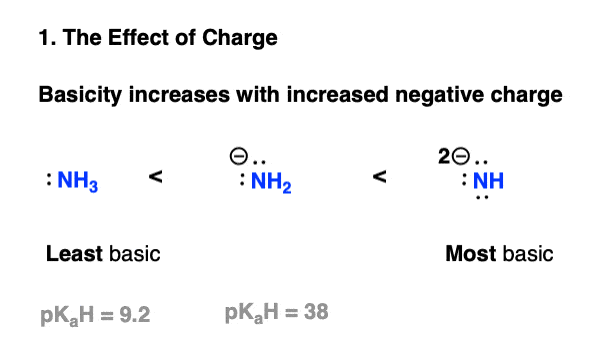
Continuing this trend, the conjugate base of the amide ion, the amide dianion NH(2-) should be an even stronger base, but it seems to be prohibitively difficult to make.
3. Basicity Trend #2: “Resonance”, or, Conjugated vs. Non-Conjugated Amines
This relationship between lower charge densities giving rise to lower basicity also applies to lone pairs that can be delocalized into a larger pi system through resonance.
You may recall that phenol (pKa = 10) is a much stronger stronger acid than cyclohexanol (pKa = 16).
Since, “the stronger the acid, the weaker the conjugate base”, this is equivalent to saying that the conjugate base of phenol is a weaker base than the conjugate base of cyclohexanol.
Why? We saw earlier that this is true because the conjugate base of phenol can be stabilized through resonance whereas the conjugate base of cyclohexanol cannot.
The oxygen in phenol is part of a larger “pi system”, and the electron density can be distributed throughout the aromatic ring via resonance. (Remember: lower charge density = more stability).

Let’s apply this to amines.
By analogy, we should also expect that aminobenzene (“aniline”) is a weaker base than cyclohexylamine.
That is indeed the case! The the pKaH of aniline is 4.6, and pKaH of cyclohexylamine is 11.2. (The higher the pKaH, the stronger the base).
The basicity is decreased even further when a second phenyl ring is attached to the nitrogen (pKaH = 0.78).
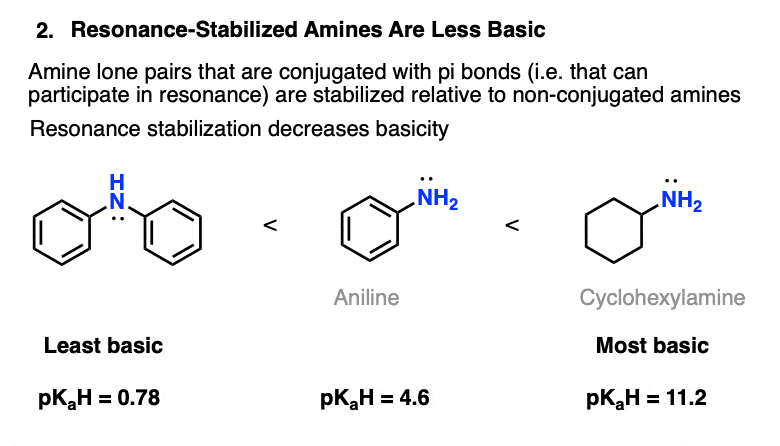
The bottom line here is that all else being equal, a conjugated amine will be less basic than a non-conjugated amine.
4. Basicity Trend #3. Inductive Effects Decrease Basicity
You may recall that electron withdrawing atoms (e.g. F or Cl) or functional groups (e.g. NO2) tend to increase acidity, by slurping away electron density from the conjugate base. Trifluoroethanol (pKa = 12.5) for example, is far more acidic than ethanol itself (pKa = 16). Lower charge density = more stability = lower basicity.
Hence, we’d expect that electron withdrawing groups on amines should likewise decrease their basicity. And they do! Witness morpholine (pKaH = 8.36) compared to piperidine (pKaH = 11), or 2-chloropyridine (pKaH = 0.49) versus pyridine (pKaH = 5.2).
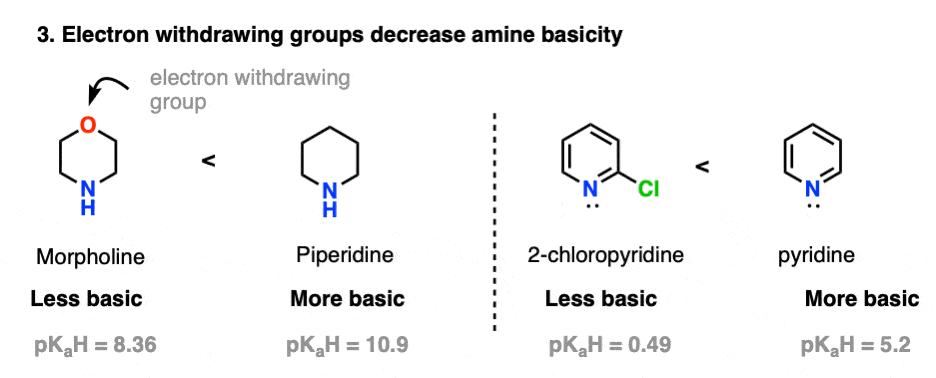
5. Basicity Trend #4: Pi-Acceptors and Pi-Donors
We’ve seen that resonance tends to decrease basicity (Factor 2) and so do inductive effects (Factor 3).
That said, how do you explain why amides are significantly less basic than amines? Is it resonance? Is it inductive effects? Is it both?

It seems worthwhile to devote a section to how the basicity of nitrogen is affected by its interactions with other functional groups in a pi-system.
Specifically, the basicity of nitrogen is decreased when it acts as a pi-donor, and the basicity of nitrogen is increased when it acts as a pi-acceptor.
6. Nitrogen Is Less Basic When It Is A Pi-Donor
Back to our amide example. Why is it less basic?
The first factor is that an electron-withdrawing oxygen is present, which can remove some of the electron density from nitrogen. However, this is outweighed by the fact that there is a significant resonance form where the nitrogen lone pair forms a new pi bond with carbon (we call this, “pi-donation“) resulting in a pair of electrons moving from the C-O pi bond to the oxygen (we call this acting as a “pi acceptor“).
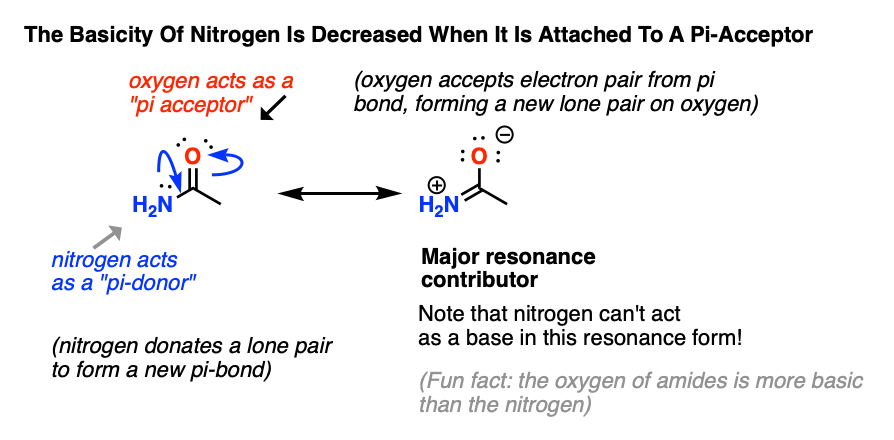
Look at that resonance form on the right. The nitrogen doesn’t have a lone pair anymore, and therefore it cannot act as a base.
Therefore, the basicity of a nitrogen is decreased when attached to a pi-acceptor.
What are pi-acceptors, again? If you’ve covered electrophilic aromatic substitution, these functional groups should seem familiar. You might recognize that “Pi acceptors” all belong in the category of “meta- directors” .

[CF3 is an example of a functional group that is a meta director but not a pi acceptor, since it has no pi bonds]
7. Nitrogen As A Pi-Acceptor
You might rightly ask if this can work in the opposite direction.
Can the basicity of a nitrogen be increased when it is attached to a pi-donor? Absolutely.
A great comparison is pyridine (pKaH = 5.2) and 4-dimethylamino pyridine (DMAP). Attachment of the strongly pi-d0nating NMe2 group to the 4-position results in a 104 increase in basicity of the ring nitrogen (pKaH = 9.2). Examining the resonance forms of DMAP is illuminating. In the key resonance form, the nitrogen in the ring bears a negative charge.
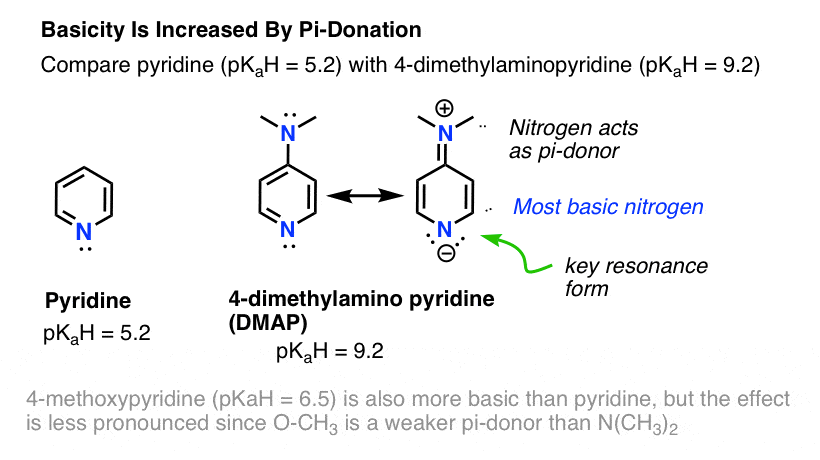
The ring nitrogen of DMAP is the most basic nitrogen, not the NMe2! The NMe2 is made less basic by being a pi-donor (see above) but the pyridine nitrogen is made more basic because it is the pi-acceptor here.
Another example of how basicity of nitrogen can be increased by attachment to pi-donors is found in guanidines. In guanidine there are two pi-donating NH2 groups which can donate electron density to the (pi-accepting) C=NH.
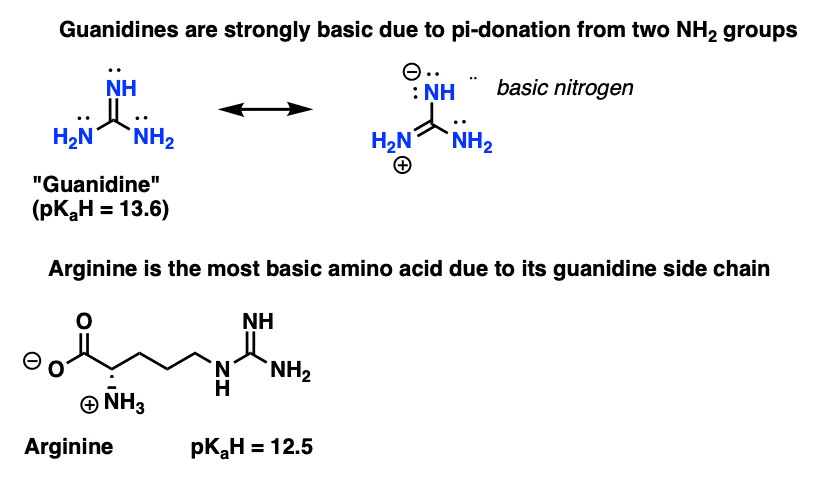
Those of you who have studied some biochemistry might recall that arginine is the most basic of all the 20 essential amino acids (pKaH = 12.5).
8. Basicity Trend#5 : Hybridization
One of the more remarkable acidity trends is that alkynes are unusually acidic (pKa = 25) relative to alkenes (pKa‘s around 43) and alkanes (pKa‘s >50).
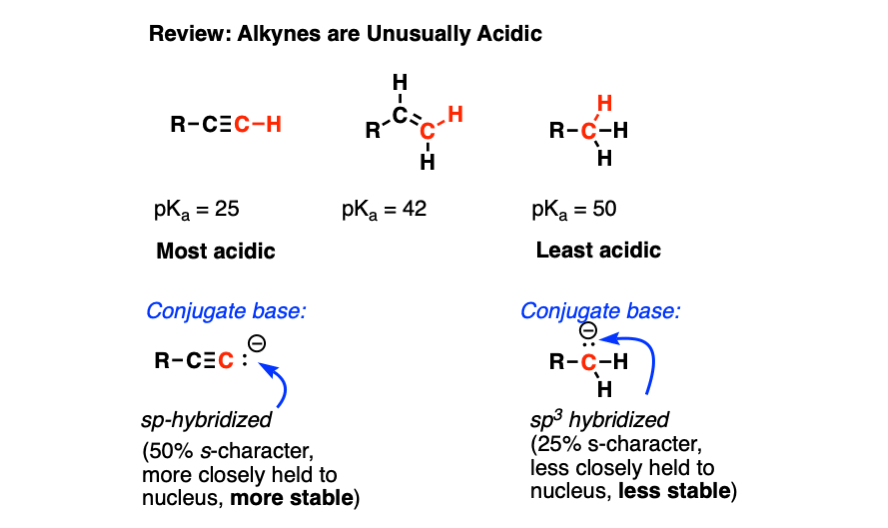
You might recall that our explanation for this effect was that the sp-hybridized orbitals of alkynes bear 50% s-character, and as the 2s orbital is closer to the nucleus than the 2p orbitals, the resulting lone pair of the conjugate base “feels” more of the positive charge from the nucleus than would a lone pair in an sp3 hybridized orbital (25% s-character). It’s similar to why a lone pair is more stable on a more electronegative atom like fluorine than on a less electronegative atom like carbon.
Knowing this, how would you predict the relative basicity of nitriles, pyridine, and piperidine?
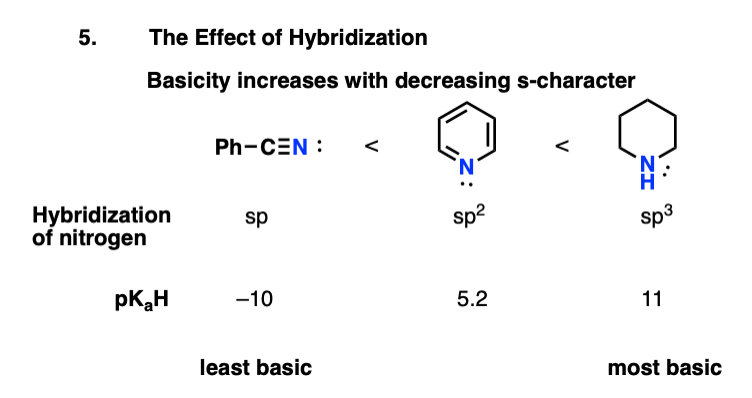
By analogy to alkynes, we’d expect the lone pairs in sp-hybridized nitriles to be the most stable and hence the least basic. We’d therefore expect the lone pairs in sp3-hybridized amines to be the least stable and hence the most basic.
This is borne out by pKaH values. The pKaH of benzonitrile (pKaH = –10) indicates that nitriles are very weak bases indeed. We can likewise explain the lower basicity of pyridine (pKaH = 5.2) versus piperidine (pKaH = 11) by the orbital hybridization.
(Not resonance, by the way! The lone pair in pyridine is in the plane of the ring, and thus not in conjugation with the p-orbitals).
9. Bonus Factor: Aromaticity
Classic exam question. What’s more basic, pyridine or pyrrole?
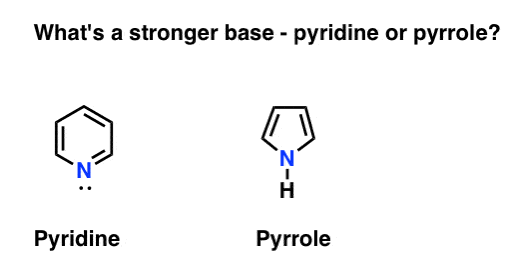
It turns out that the nitrogen in pyrrole is unusually non-basic. In fact, even when subjected to acid, pyrrole reacts at carbon (C-2), and not on the nitrogen. Pyridine [pKaH = 5.2] is far more basic than pyrrole [pKaH about –3.6 ]
Why?
Draw the conjugate acid of pyrrole. Notice anything?
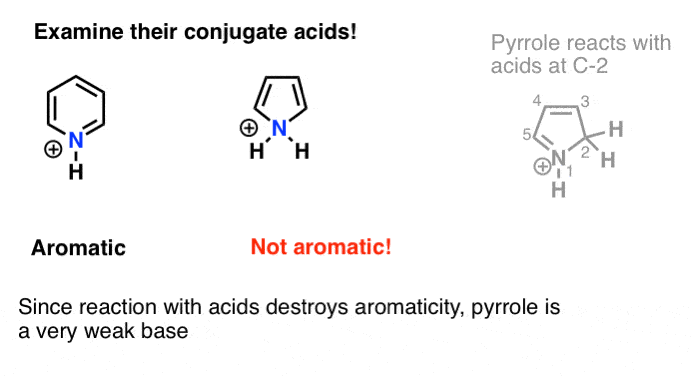
The conjugate acid is not aromatic. Removal of the lone pair on nitrogen through protonation would destroy the conjugation of the lone pair with the other p orbitals of the ring and render the molecule non aromatic.
This might ring a distant bell. You might remember that cyclopentadiene is an unusually strong acid for a hydrocarbon. We can restate this as “the conjugate base of cyclopentadiene is unusually weak”.
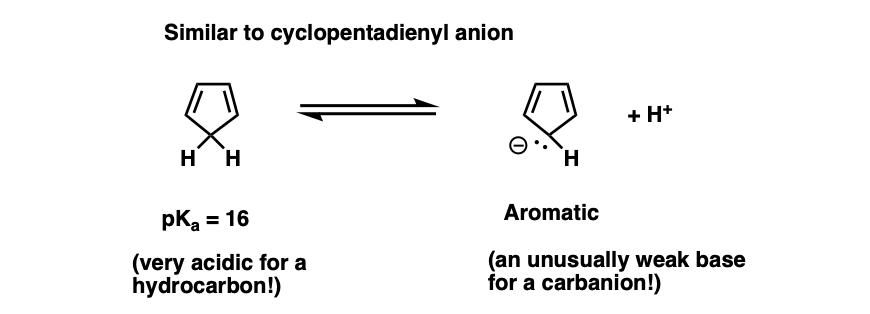
See the analogy with pyrrole? Protonation of the cyclopentadienyl anion destroys aromaticity.
The bottom line here is to be on the lookout for situations where forming a new N-H bond might disrupt aromaticity. [Note 2]
Can you apply the same concept in the question below?

10. Summary: Amine Basicity Trends
OK, I said there were 5 factors which affected acidity, but I covered six factors here. The reason is that “pi donation” and “pi accepting” behaviour often doesn’t get covered that much in Org 1 (when acidity is introduced) but by the time most students encounter amines, they’ve encountered these concepts in the context of electrophilic aromatic substitution.
The key lesson for today is this: since “the stronger the acid, the weaker the conjugate base” and “the weaker the acid, the stronger the conjugate base”, every factor that affects acidity is likewise a factor that affects basicity.
If you understand the factors that stabilize negative charge (and therefore make an atom less basic), by definition you also understand the factors that destabilize negative charge (and therefore make an atom more basic).
How do we handle situations where multiple factors come into play? We must resort to experimental measurement (pKaH). It’s too difficult to predict trends when more than one variable is being changed at once.
In the next post we’ll look at a very specific example of this – and, I may add, a common exam problem. : – )
Thanks to Prof. Paul Wenthold (Purdue U) for a very helpful email.
Notes
Related Articles
Note 1. Because we’re only discussing the basicity of nitrogen here, the atomic factors of electronegativity and polarizability aren’t discussed.
Recall, however, that across a row of the periodic table, basicity is inversely correlated with electronegativity. H3C(-) is more basic than H2N(-) which is more basic than HO(-) which is more basic than F(-). The less electronegative the element, the less stable the lone pair will be and therefore the higher will be its basicity.
Another useful trend is that basicity decreases as you go down a column of the periodic table. This is because the valence orbitals increase in size as one descends a column of the periodic table. The electrons will therefore be “spread out” over a larger volume, resulting in lower charge density . Our common way of describing this is by using the term “polarizability”.
Note 2. Here’s a fun example where nitrogen is unusually basic due to aromaticity. A family of imine “superbases” has been developed by the research group of Tristan Lambert at Columbia (update: now Cornell)
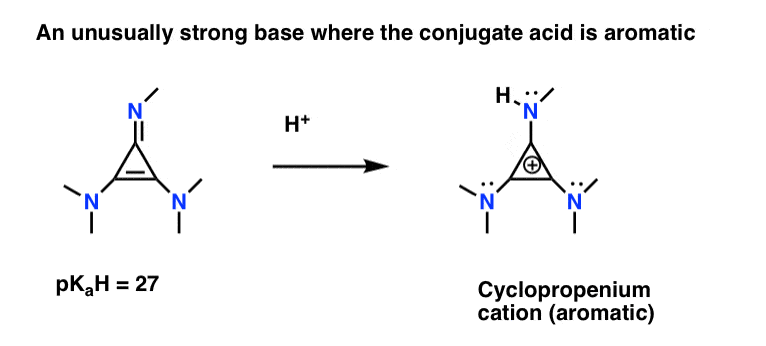
Note how a significant resonance form of the conjugate acid is a substituted version of the aromatic cyclopropenium cation. This helps to drive the equilibrium towards the conjugate acid. The pKaH here is about 27!
See: Jeffrey S Bandar and Tristan H Lambert, Journal of the American Chemical Society, 134(12), 5552-5555 (2012)
Note 4. Some pKa values of protonated nitrogen:
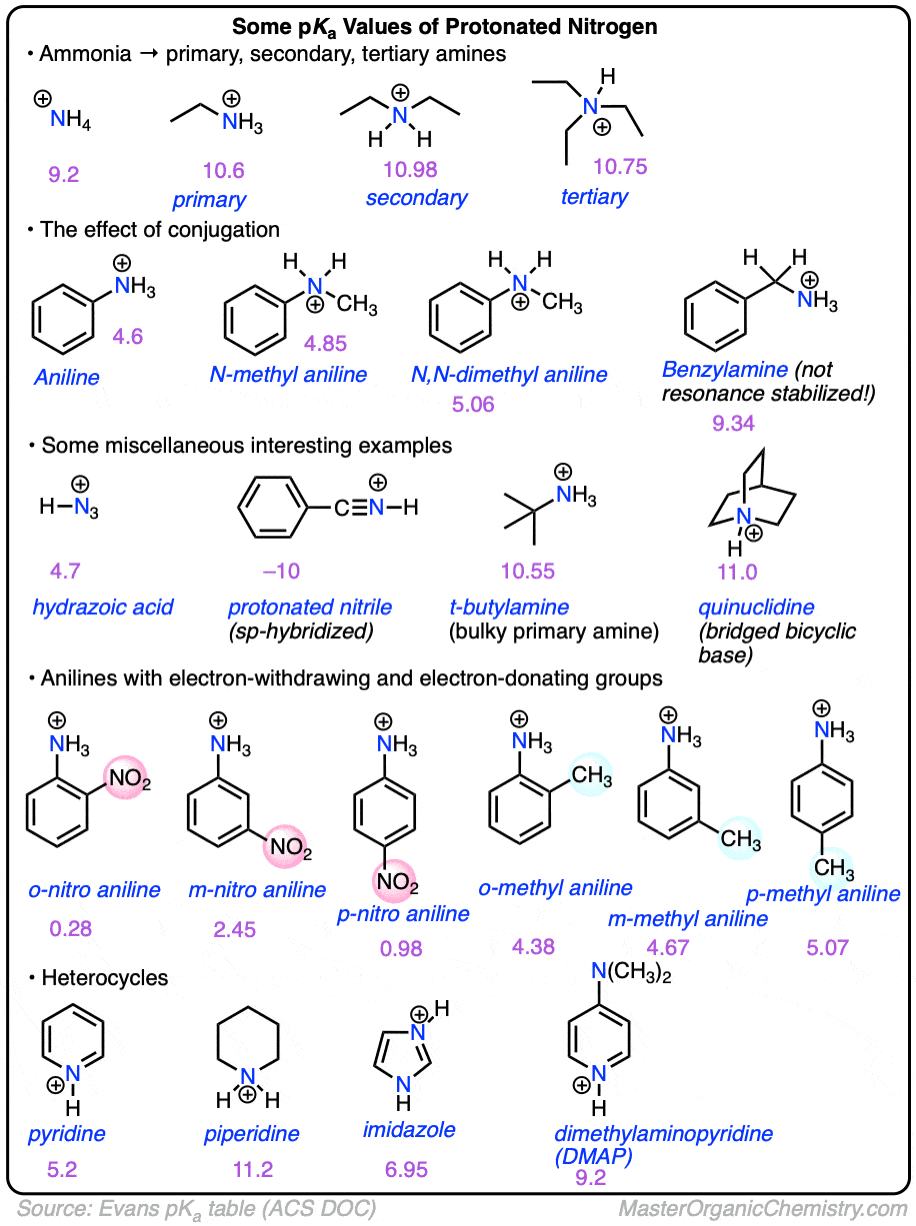
(Advanced) References and Further Reading
- Basicity of N-substituted anilines and pyridine in dimethylsulfoxide
Robert L. Benoit, Moyra J. Mackinnon, and Leon Bergeron
Can J. Chem. 59, 1501 1981
DOI: 10.1139/v81-220
“[For amines] in the gas phase the basicity order is Me3N > Me2NH > n-PrNH2 > MeNH2 > NH3 while in the solvent dimethylsulfoxide (Me2SO) the order becomes MeNH2 ~ EtNH2 > nPrNH2 > NH3 ~ Me2NH >> Me3N. Thus NH3 is more basic than Me3N by 2.0 pK units. Then in water, the sequence changes to Me2NH ~ EtNH2 ~ MeNH2 ~ n-PrNH2 > Me3N > NH3 so that NH3 is now a weaker base than Me3N with a 0.6 pK difference. “
00 General Chemistry Review
01 Bonding, Structure, and Resonance
- How Do We Know Methane (CH4) Is Tetrahedral?
- Hybrid Orbitals and Hybridization
- How To Determine Hybridization: A Shortcut
- Orbital Hybridization And Bond Strengths
- Sigma bonds come in six varieties: Pi bonds come in one
- Dipole Moments and Dipoles
- A Key Skill: How to Calculate Formal Charge
- The Four Intermolecular Forces and How They Affect Boiling Points
- 3 Trends That Affect Boiling Points
- How To Use Electronegativity To Determine Electron Density (and why NOT to trust formal charge)
- Introduction to Resonance
- How To Use Curved Arrows To Interchange Resonance Forms
- Evaluating Resonance Forms (1) - The Rule of Least Charges
- How To Find The Best Resonance Structure By Applying Electronegativity
- Evaluating Resonance Structures With Negative Charges
- Evaluating Resonance Structures With Positive Charge
- Exploring Resonance: Pi-Donation
- Exploring Resonance: Pi-acceptors
- In Summary: Evaluating Resonance Structures
- Drawing Resonance Structures: 3 Common Mistakes To Avoid
- How to apply electronegativity and resonance to understand reactivity
- Bond Hybridization Practice
- Structure and Bonding Practice Quizzes
- Resonance Structures Practice
02 Acid Base Reactions
- Introduction to Acid-Base Reactions
- Acid Base Reactions In Organic Chemistry
- The Stronger The Acid, The Weaker The Conjugate Base
- Walkthrough of Acid-Base Reactions (3) - Acidity Trends
- Five Key Factors That Influence Acidity
- Acid-Base Reactions: Introducing Ka and pKa
- How to Use a pKa Table
- The pKa Table Is Your Friend
- A Handy Rule of Thumb for Acid-Base Reactions
- Acid Base Reactions Are Fast
- pKa Values Span 60 Orders Of Magnitude
- How Protonation and Deprotonation Affect Reactivity
- Acid Base Practice Problems
03 Alkanes and Nomenclature
- Meet the (Most Important) Functional Groups
- Condensed Formulas: Deciphering What the Brackets Mean
- Hidden Hydrogens, Hidden Lone Pairs, Hidden Counterions
- Don't Be Futyl, Learn The Butyls
- Primary, Secondary, Tertiary, Quaternary In Organic Chemistry
- Branching, and Its Affect On Melting and Boiling Points
- The Many, Many Ways of Drawing Butane
- Wedge And Dash Convention For Tetrahedral Carbon
- Common Mistakes in Organic Chemistry: Pentavalent Carbon
- Table of Functional Group Priorities for Nomenclature
- Summary Sheet - Alkane Nomenclature
- Organic Chemistry IUPAC Nomenclature Demystified With A Simple Puzzle Piece Approach
- Boiling Point Quizzes
- Organic Chemistry Nomenclature Quizzes
04 Conformations and Cycloalkanes
- Staggered vs Eclipsed Conformations of Ethane
- Conformational Isomers of Propane
- Newman Projection of Butane (and Gauche Conformation)
- Introduction to Cycloalkanes
- Geometric Isomers In Small Rings: Cis And Trans Cycloalkanes
- Calculation of Ring Strain In Cycloalkanes
- Cycloalkanes - Ring Strain In Cyclopropane And Cyclobutane
- Cyclohexane Conformations
- Cyclohexane Chair Conformation: An Aerial Tour
- How To Draw The Cyclohexane Chair Conformation
- The Cyclohexane Chair Flip
- The Cyclohexane Chair Flip - Energy Diagram
- Substituted Cyclohexanes - Axial vs Equatorial
- Ranking The Bulkiness Of Substituents On Cyclohexanes: "A-Values"
- Cyclohexane Chair Conformation Stability: Which One Is Lower Energy?
- Fused Rings - Cis-Decalin and Trans-Decalin
- Naming Bicyclic Compounds - Fused, Bridged, and Spiro
- Bredt's Rule (And Summary of Cycloalkanes)
- Newman Projection Practice
- Cycloalkanes Practice Problems
05 A Primer On Organic Reactions
- The Most Important Question To Ask When Learning a New Reaction
- Curved Arrows (for reactions)
- Nucleophiles and Electrophiles
- The Three Classes of Nucleophiles
- Nucleophilicity vs. Basicity
- What Makes A Good Nucleophile?
- What Makes A Good Leaving Group?
- 3 Factors That Stabilize Carbocations
- Equilibrium and Energy Relationships
- 7 Factors that stabilize negative charge in organic chemistry
- 7 Factors That Stabilize Positive Charge in Organic Chemistry
- What's a Transition State?
- Hammond's Postulate
- Learning Organic Chemistry Reactions: A Checklist (PDF)
06 Free Radical Reactions
- Free Radical Reactions
- 3 Factors That Stabilize Free Radicals
- Bond Strengths And Radical Stability
- Free Radical Initiation: Why Is "Light" Or "Heat" Required?
- Initiation, Propagation, Termination
- Monochlorination Products Of Propane, Pentane, And Other Alkanes
- Selectivity In Free Radical Reactions
- Selectivity in Free Radical Reactions: Bromination vs. Chlorination
- Halogenation At Tiffany's
- Allylic Bromination
- Bonus Topic: Allylic Rearrangements
- In Summary: Free Radicals
- Synthesis (2) - Reactions of Alkanes
- Free Radicals Practice Quizzes
07 Stereochemistry and Chirality
- Types of Isomers: Constitutional Isomers, Stereoisomers, Enantiomers, and Diastereomers
- How To Draw The Enantiomer Of A Chiral Molecule
- How To Draw A Bond Rotation
- Introduction to Assigning (R) and (S): The Cahn-Ingold-Prelog Rules
- Assigning Cahn-Ingold-Prelog (CIP) Priorities (2) - The Method of Dots
- Enantiomers vs Diastereomers vs The Same? Two Methods For Solving Problems
- Assigning R/S To Newman Projections (And Converting Newman To Line Diagrams)
- How To Determine R and S Configurations On A Fischer Projection
- The Meso Trap
- Optical Rotation, Optical Activity, and Specific Rotation
- Optical Purity and Enantiomeric Excess
- What's a Racemic Mixture?
- Chiral Allenes And Chiral Axes
- Stereochemistry Practice Problems and Quizzes
08 Substitution Reactions
- Nucleophilic Substitution Reactions - Introduction
- Two Types of Nucleophilic Substitution Reactions
- The SN2 Mechanism
- Why the SN2 Reaction Is Powerful
- The SN1 Mechanism
- The Conjugate Acid Is A Better Leaving Group
- Comparing the SN1 and SN2 Reactions
- Polar Protic? Polar Aprotic? Nonpolar? All About Solvents
- Steric Hindrance is Like a Fat Goalie
- Common Blind Spot: Intramolecular Reactions
- Substitution Practice - SN1
- Substitution Practice - SN2
09 Elimination Reactions
- Elimination Reactions (1): Introduction And The Key Pattern
- Elimination Reactions (2): The Zaitsev Rule
- Elimination Reactions Are Favored By Heat
- Two Elimination Reaction Patterns
- The E1 Reaction
- The E2 Mechanism
- E1 vs E2: Comparing the E1 and E2 Reactions
- Antiperiplanar Relationships: The E2 Reaction and Cyclohexane Rings
- Bulky Bases in Elimination Reactions
- Comparing the E1 vs SN1 Reactions
- Elimination (E1) Reactions With Rearrangements
- E1cB - Elimination (Unimolecular) Conjugate Base
- Elimination (E1) Practice Problems And Solutions
- Elimination (E2) Practice Problems and Solutions
10 Rearrangements
11 SN1/SN2/E1/E2 Decision
- Identifying Where Substitution and Elimination Reactions Happen
- Deciding SN1/SN2/E1/E2 (1) - The Substrate
- Deciding SN1/SN2/E1/E2 (2) - The Nucleophile/Base
- SN1 vs E1 and SN2 vs E2 : The Temperature
- Deciding SN1/SN2/E1/E2 - The Solvent
- Wrapup: The Key Factors For Determining SN1/SN2/E1/E2
- Alkyl Halide Reaction Map And Summary
- SN1 SN2 E1 E2 Practice Problems
12 Alkene Reactions
- E and Z Notation For Alkenes (+ Cis/Trans)
- Alkene Stability
- Alkene Addition Reactions: "Regioselectivity" and "Stereoselectivity" (Syn/Anti)
- Stereoselective and Stereospecific Reactions
- Hydrohalogenation of Alkenes and Markovnikov's Rule
- Hydration of Alkenes With Aqueous Acid
- Rearrangements in Alkene Addition Reactions
- Halogenation of Alkenes and Halohydrin Formation
- Oxymercuration Demercuration of Alkenes
- Hydroboration Oxidation of Alkenes
- m-CPBA (meta-chloroperoxybenzoic acid)
- OsO4 (Osmium Tetroxide) for Dihydroxylation of Alkenes
- Palladium on Carbon (Pd/C) for Catalytic Hydrogenation of Alkenes
- Cyclopropanation of Alkenes
- A Fourth Alkene Addition Pattern - Free Radical Addition
- Alkene Reactions: Ozonolysis
- Oxidative Cleavage of Vicinal Diols With NaIO4 and Pb(OAc)4
- Summary: Three Key Families Of Alkene Reaction Mechanisms
- Synthesis (4) - Alkene Reaction Map, Including Alkyl Halide Reactions
- Alkene Reactions Practice Problems
13 Alkyne Reactions
- Acetylides from Alkynes, And Substitution Reactions of Acetylides
- Partial Reduction of Alkynes With Lindlar's Catalyst
- Partial Reduction of Alkynes With Na/NH3 To Obtain Trans Alkenes
- Alkyne Hydroboration With "R2BH"
- Hydration and Oxymercuration of Alkynes
- Hydrohalogenation of Alkynes
- Alkyne Halogenation: Bromination and Chlorination of Alkynes
- Oxidation of Alkynes With O3 and KMnO4
- Alkenes To Alkynes Via Halogenation And Elimination Reactions
- Alkynes Are A Blank Canvas
- Synthesis (5) - Reactions of Alkynes
- Alkyne Reactions Practice Problems With Answers
14 Alcohols, Epoxides and Ethers
- Alcohols - Nomenclature and Properties
- Alcohols Can Act As Acids Or Bases (And Why It Matters)
- Alcohols - Acidity and Basicity
- The Williamson Ether Synthesis
- Ethers From Alkenes, Tertiary Alkyl Halides and Alkoxymercuration
- Alcohols To Ethers via Acid Catalysis
- Cleavage Of Ethers With Acid
- Epoxides - The Outlier Of The Ether Family
- Opening of Epoxides With Acid
- Epoxide Ring Opening With Base
- Making Alkyl Halides From Alcohols
- Tosylates And Mesylates
- PBr3 and SOCl2
- Elimination Reactions of Alcohols
- Elimination of Alcohols To Alkenes With POCl3
- Alcohol Oxidation: "Strong" and "Weak" Oxidants
- Demystifying The Mechanisms of Alcohol Oxidations
- Protecting Groups For Alcohols
- Thiols And Thioethers
- Calculating the oxidation state of a carbon
- Oxidation and Reduction in Organic Chemistry
- Oxidation Ladders
- SOCl2 Mechanism For Alcohols To Alkyl Halides: SN2 versus SNi
- Alcohol Reactions Roadmap (PDF)
- Alcohol Reaction Practice Problems
- Epoxide Reaction Quizzes
- Oxidation and Reduction Practice Quizzes
15 Organometallics
- What's An Organometallic?
- Formation of Grignard and Organolithium Reagents
- Organometallics Are Strong Bases
- Reactions of Grignard Reagents
- Protecting Groups In Grignard Reactions
- Synthesis Problems Involving Grignard Reagents
- Grignard Reactions And Synthesis (2)
- Organocuprates (Gilman Reagents): How They're Made
- Gilman Reagents (Organocuprates): What They're Used For
- The Heck, Suzuki, and Olefin Metathesis Reactions (And Why They Don't Belong In Most Introductory Organic Chemistry Courses)
- Reaction Map: Reactions of Organometallics
- Grignard Practice Problems
16 Spectroscopy
- Degrees of Unsaturation (or IHD, Index of Hydrogen Deficiency)
- Conjugation And Color (+ How Bleach Works)
- Introduction To UV-Vis Spectroscopy
- UV-Vis Spectroscopy: Absorbance of Carbonyls
- UV-Vis Spectroscopy: Practice Questions
- Bond Vibrations, Infrared Spectroscopy, and the "Ball and Spring" Model
- Infrared (IR) Spectroscopy: A Quick Primer On Interpreting Spectra
- IR Spectroscopy: 4 Practice Problems
- 1H NMR: How Many Signals?
- Homotopic, Enantiotopic, Diastereotopic
- Diastereotopic Protons in 1H NMR Spectroscopy: Examples
- 13-C NMR - How Many Signals
- Liquid Gold: Pheromones In Doe Urine
- Natural Product Isolation (1) - Extraction
- Natural Product Isolation (2) - Purification Techniques, An Overview
- Structure Determination Case Study: Deer Tarsal Gland Pheromone
17 Dienes and MO Theory
- What To Expect In Organic Chemistry 2
- Are these molecules conjugated?
- Conjugation And Resonance In Organic Chemistry
- Bonding And Antibonding Pi Orbitals
- Molecular Orbitals of The Allyl Cation, Allyl Radical, and Allyl Anion
- Pi Molecular Orbitals of Butadiene
- Reactions of Dienes: 1,2 and 1,4 Addition
- Thermodynamic and Kinetic Products
- More On 1,2 and 1,4 Additions To Dienes
- s-cis and s-trans
- The Diels-Alder Reaction
- Cyclic Dienes and Dienophiles in the Diels-Alder Reaction
- Stereochemistry of the Diels-Alder Reaction
- Exo vs Endo Products In The Diels Alder: How To Tell Them Apart
- HOMO and LUMO In the Diels Alder Reaction
- Why Are Endo vs Exo Products Favored in the Diels-Alder Reaction?
- Diels-Alder Reaction: Kinetic and Thermodynamic Control
- The Retro Diels-Alder Reaction
- The Intramolecular Diels Alder Reaction
- Regiochemistry In The Diels-Alder Reaction
- The Cope and Claisen Rearrangements
- Electrocyclic Reactions
- Electrocyclic Ring Opening And Closure (2) - Six (or Eight) Pi Electrons
- Diels Alder Practice Problems
- Molecular Orbital Theory Practice
18 Aromaticity
- Introduction To Aromaticity
- Rules For Aromaticity
- Huckel's Rule: What Does 4n+2 Mean?
- Aromatic, Non-Aromatic, or Antiaromatic? Some Practice Problems
- Antiaromatic Compounds and Antiaromaticity
- The Pi Molecular Orbitals of Benzene
- The Pi Molecular Orbitals of Cyclobutadiene
- Frost Circles
- Aromaticity Practice Quizzes
19 Reactions of Aromatic Molecules
- Electrophilic Aromatic Substitution: Introduction
- Activating and Deactivating Groups In Electrophilic Aromatic Substitution
- Electrophilic Aromatic Substitution - The Mechanism
- Ortho-, Para- and Meta- Directors in Electrophilic Aromatic Substitution
- Understanding Ortho, Para, and Meta Directors
- Why are halogens ortho- para- directors?
- Disubstituted Benzenes: The Strongest Electron-Donor "Wins"
- Electrophilic Aromatic Substitutions (1) - Halogenation of Benzene
- Electrophilic Aromatic Substitutions (2) - Nitration and Sulfonation
- EAS Reactions (3) - Friedel-Crafts Acylation and Friedel-Crafts Alkylation
- Intramolecular Friedel-Crafts Reactions
- Nucleophilic Aromatic Substitution (NAS)
- Nucleophilic Aromatic Substitution (2) - The Benzyne Mechanism
- Reactions on the "Benzylic" Carbon: Bromination And Oxidation
- The Wolff-Kishner, Clemmensen, And Other Carbonyl Reductions
- More Reactions on the Aromatic Sidechain: Reduction of Nitro Groups and the Baeyer Villiger
- Aromatic Synthesis (1) - "Order Of Operations"
- Synthesis of Benzene Derivatives (2) - Polarity Reversal
- Aromatic Synthesis (3) - Sulfonyl Blocking Groups
- Birch Reduction
- Synthesis (7): Reaction Map of Benzene and Related Aromatic Compounds
- Aromatic Reactions and Synthesis Practice
- Electrophilic Aromatic Substitution Practice Problems
20 Aldehydes and Ketones
- What's The Alpha Carbon In Carbonyl Compounds?
- Nucleophilic Addition To Carbonyls
- Aldehydes and Ketones: 14 Reactions With The Same Mechanism
- Sodium Borohydride (NaBH4) Reduction of Aldehydes and Ketones
- Grignard Reagents For Addition To Aldehydes and Ketones
- Wittig Reaction
- Hydrates, Hemiacetals, and Acetals
- Imines - Properties, Formation, Reactions, and Mechanisms
- All About Enamines
- Breaking Down Carbonyl Reaction Mechanisms: Reactions of Anionic Nucleophiles (Part 2)
- Aldehydes Ketones Reaction Practice
21 Carboxylic Acid Derivatives
- Nucleophilic Acyl Substitution (With Negatively Charged Nucleophiles)
- Addition-Elimination Mechanisms With Neutral Nucleophiles (Including Acid Catalysis)
- Basic Hydrolysis of Esters - Saponification
- Transesterification
- Proton Transfer
- Fischer Esterification - Carboxylic Acid to Ester Under Acidic Conditions
- Lithium Aluminum Hydride (LiAlH4) For Reduction of Carboxylic Acid Derivatives
- LiAlH[Ot-Bu]3 For The Reduction of Acid Halides To Aldehydes
- Di-isobutyl Aluminum Hydride (DIBAL) For The Partial Reduction of Esters and Nitriles
- Amide Hydrolysis
- Thionyl Chloride (SOCl2) And Conversion of Carboxylic Acids to Acid Halides
- Diazomethane (CH2N2)
- Carbonyl Chemistry: Learn Six Mechanisms For the Price Of One
- Making Music With Mechanisms (PADPED)
- Carboxylic Acid Derivatives Practice Questions
22 Enols and Enolates
- Keto-Enol Tautomerism
- Enolates - Formation, Stability, and Simple Reactions
- Kinetic Versus Thermodynamic Enolates
- Aldol Addition and Condensation Reactions
- Reactions of Enols - Acid-Catalyzed Aldol, Halogenation, and Mannich Reactions
- Claisen Condensation and Dieckmann Condensation
- Decarboxylation
- The Malonic Ester and Acetoacetic Ester Synthesis
- The Michael Addition Reaction and Conjugate Addition
- The Robinson Annulation
- Haloform Reaction
- The Hell–Volhard–Zelinsky Reaction
- Enols and Enolates Practice Quizzes
23 Amines
- The Amide Functional Group: Properties, Synthesis, and Nomenclature
- Basicity of Amines And pKaH
- 5 Key Basicity Trends of Amines
- The Mesomeric Effect And Aromatic Amines
- Nucleophilicity of Amines
- Alkylation of Amines (Sucks!)
- Reductive Amination
- The Gabriel Synthesis
- Some Reactions of Azides
- The Hofmann Elimination
- The Hofmann and Curtius Rearrangements
- The Cope Elimination
- Protecting Groups for Amines - Carbamates
- The Strecker Synthesis of Amino Acids
- Introduction to Peptide Synthesis
- Reactions of Diazonium Salts: Sandmeyer and Related Reactions
- Amine Practice Questions
24 Carbohydrates
- D and L Notation For Sugars
- Pyranoses and Furanoses: Ring-Chain Tautomerism In Sugars
- What is Mutarotation?
- Reducing Sugars
- The Big Damn Post Of Carbohydrate-Related Chemistry Definitions
- The Haworth Projection
- Converting a Fischer Projection To A Haworth (And Vice Versa)
- Reactions of Sugars: Glycosylation and Protection
- The Ruff Degradation and Kiliani-Fischer Synthesis
- Isoelectric Points of Amino Acids (and How To Calculate Them)
- Carbohydrates Practice
- Amino Acid Quizzes
25 Fun and Miscellaneous
- A Gallery of Some Interesting Molecules From Nature
- Screw Organic Chemistry, I'm Just Going To Write About Cats
- On Cats, Part 1: Conformations and Configurations
- On Cats, Part 2: Cat Line Diagrams
- On Cats, Part 4: Enantiocats
- On Cats, Part 6: Stereocenters
- Organic Chemistry Is Shit
- The Organic Chemistry Behind "The Pill"
- Maybe they should call them, "Formal Wins" ?
- Why Do Organic Chemists Use Kilocalories?
- The Principle of Least Effort
- Organic Chemistry GIFS - Resonance Forms
- Reproducibility In Organic Chemistry
- What Holds The Nucleus Together?
- How Reactions Are Like Music
- Organic Chemistry and the New MCAT
26 Organic Chemistry Tips and Tricks
- Common Mistakes: Formal Charges Can Mislead
- Partial Charges Give Clues About Electron Flow
- Draw The Ugly Version First
- Organic Chemistry Study Tips: Learn the Trends
- The 8 Types of Arrows In Organic Chemistry, Explained
- Top 10 Skills To Master Before An Organic Chemistry 2 Final
- Common Mistakes with Carbonyls: Carboxylic Acids... Are Acids!
- Planning Organic Synthesis With "Reaction Maps"
- Alkene Addition Pattern #1: The "Carbocation Pathway"
- Alkene Addition Pattern #2: The "Three-Membered Ring" Pathway
- Alkene Addition Pattern #3: The "Concerted" Pathway
- Number Your Carbons!
- The 4 Major Classes of Reactions in Org 1
- How (and why) electrons flow
- Grossman's Rule
- Three Exam Tips
- A 3-Step Method For Thinking Through Synthesis Problems
- Putting It Together
- Putting Diels-Alder Products in Perspective
- The Ups and Downs of Cyclohexanes
- The Most Annoying Exceptions in Org 1 (Part 1)
- The Most Annoying Exceptions in Org 1 (Part 2)
- The Marriage May Be Bad, But the Divorce Still Costs Money
- 9 Nomenclature Conventions To Know
- Nucleophile attacks Electrophile
27 Case Studies of Successful O-Chem Students
- Success Stories: How Corina Got The The "Hard" Professor - And Got An A+ Anyway
- How Helena Aced Organic Chemistry
- From a "Drop" To B+ in Org 2 – How A Hard Working Student Turned It Around
- How Serge Aced Organic Chemistry
- Success Stories: How Zach Aced Organic Chemistry 1
- Success Stories: How Kari Went From C– to B+
- How Esther Bounced Back From a "C" To Get A's In Organic Chemistry 1 And 2
- How Tyrell Got The Highest Grade In Her Organic Chemistry Course
- This Is Why Students Use Flashcards
- Success Stories: How Stu Aced Organic Chemistry
- How John Pulled Up His Organic Chemistry Exam Grades
- Success Stories: How Nathan Aced Organic Chemistry (Without It Taking Over His Life)
- How Chris Aced Org 1 and Org 2
- Interview: How Jay Got an A+ In Organic Chemistry
- How to Do Well in Organic Chemistry: One Student's Advice
- "America's Top TA" Shares His Secrets For Teaching O-Chem
- "Organic Chemistry Is Like..." - A Few Metaphors
- How To Do Well In Organic Chemistry: Advice From A Tutor
- Guest post: "I went from being afraid of tests to actually looking forward to them".
sir, why is basicity NH3 < aniline in gas phase? Nitrogen of NH3 is sp3 and aniline is sp2.
And, why is basicity aniline < NH3 in water?
Hi James,
In the summary card/diagram, you say that basicity increases with increasing s character. But it should say “decreasing” s-character like you did below.
Thanks for the catch. Fixed!!
sir. i am working on oleylamine ligand but it is hard acidity. i like to convert into softer amine ligand bu screening its tail. whats your suggestion to got softer oleylammonium ion for interaction with soft iodide in CsPbI3 QDs structure
The subpoint no.2, in point 3 – How’s aniline more basic (i.e. less acidic) than the other compound (with 2 benzene rings) ? Doesnt the lone pair get distributed on both rings as opposed to one? And if that happens then neither of the rings will have good resonance. But with Aniline that’s not the case. Kindly clarify my confusion. Thank you :).
The key point is that in diphenylamine the lone pair on nitrogen can be delocalized through two aromatic rings. Maybe I’m not fully grasping your question, but this doesn’t appear to have any significant impact on the resonance (or aromaticity) of the aromatic rings, given the low value obtained for the pKa of protonated diphenylamine.
Thank you very much for the quick reply, I am really interested in the nucleophilic capacity of these compounds, I have read that basicity and nucleophilic capacity are related, in this case does the chain length affect the nucleophilic capacity or is it still negligible?
Hi Natalia – they should be about the same order of magnitude. This table on Herbert Mayr’s site may be useful. https://www.cup.lmu.de/oc/mayr/reaktionsdatenbank/fe/showclass/41
Dear Dr James
I am working with propylamine and octylamine, Tthe difference between them is the carbonate chain, but which one is more basic
They have negligible difference in basicity, within a factor of 10.
Dear Dr James!
Just to appreciate you for your effort which is a great help for both students and instructor both. Keep it up. Master Organic Chemistry is In-depth concept source with incredibly simplest yet technical way.
Glad you find it useful. Thank you
Thanks a lot. Literally i have not seen anywhere throughout the internet where organic chemistry is taught in such a beautiful manner.Hats off to you. You have amazing teaching skills.Please feel proud of yourself.
Thank you very much for doing this. Helped in understanding organic chemistry a lot. Thank you!!
Glad to hear it. Thanks Goutham.
Quite impressive explanation……!
Sir, can u tell me why o-methyl aniline is less basic than aniline despite electron donating tendencies of -CH3 group? It seems Steric Inhibition of Resonance is the answer. But how?
In order for the oxygen to be able to donate its pair of electrons into the ring, it has to adopt sp2 hybridization (trigonal planar geometry). This puts the methyl group attached to the oxygen in the same plane as the aromatic ring. If you draw it out, you should see the problem!
sir please give some information about pyramidal inversion( not only amine inversion).
i’m really confused .also discuss the cases in which inversion will occur. Also is inversion there in cyclic compounds containing nitrogrn phosphorous etc. and plz do it early , my exam is close.
thanks
Pyrimidal inversion: important for nitrogen, but doesn’t happen (at low temperatures anyway) for phosphorus. Look at a chiral phosphine like DIPAMP for instance. You can resolve it.
Inversion of amines passes through an sp2 hybridized intermediate, so when sp2 hybridization is disfavored due to strain it is less likely. Aziridines, for example, as well as in bases like quinuclidine and dabco.
Sir, what will be effect of n-pyramidal inversion on the basicity of amines?
In inversion of amines an sp3 hybridized nitrogen passes through a planar sp2 intermediate en route to the inverted sp3 nitrogen. In theory one would expect that an sp3 hybridized nitrogen would be more basic than an sp2 hybridized nitrogen than an sp hybridized nitrogen. Amines are more basic than nitriles after all. Therefore one could look at nitrogens in systems where inversion is impossible and compare their basicities to nitrogens where inversion happens. One good comparison would be, say, triethylamine with quinuclidine. The pkaH of triethylamine is 10.75 versus 11.0 for quinuclidine, indicating that this could indeed have a minor effect. Great question. See the Evans pka table: http://evans.rc.fas.harvard.edu/pdf/evans_pKa_table.pdf
Great question Mudasir. Basicity decreases with amine s-character, so sp3 nitrogen is more basic than sp2 which is more basic than sp. Inversion of amines involves passing through an sp2 hybridized intermediate. Drawing an an analogy with resonance, you can think of this as a contribution of “sp2 character” to the overall basicity of the amine. When you have a base like quinuclidine or DABCO that can’t invert there is a lower population of sp2 hybridized nitrogen, therefore one would expect higher basicity. That’s my stab at it. James
Thank you for granting access to the informative and educational technical paper. My question is: if I want to reverse the Lyotropic selectivity of sulfate first and chloride second in a Type 1 strong base anion exchange resin (tertiary amine or quaternary amine) to chloride first and sulfate second, what high basicity amines are best suited in the amination step post chloromethylation? Thank you.